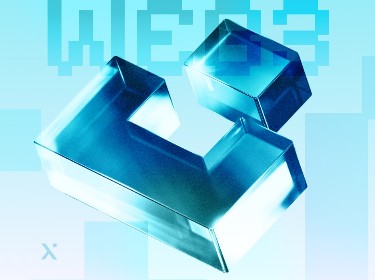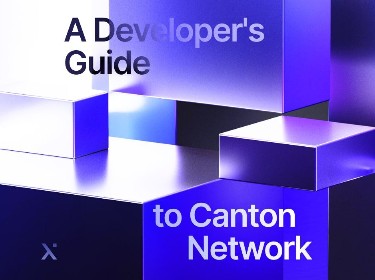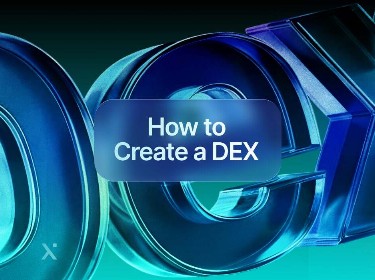The world of decentralized finance can feel complex, which discourages some businesses from engaging in DeFi development. However, with the right guidance, building a successful DeFi platform and staying at the forefront of innovation is well within reach.
As the number of DeFi users is projected to reach 53.56 million in 2025, it is clear that DeFi is gaining traction and popularity. Once a relatively unknown concept, decentralized finance has recently captured the interest of many businesses that are eager to build their own DeFi apps.
However, it is also fair to say that DeFi development is no small feat. It demands meticulous attention to numerous details, which can feel overwhelming and deter some potential adopters from building their own DeFi platforms.
But our team has the expertise to navigate these challenges and turn them into opportunities.
In this blog post, we will share how to create a thriving DeFi platform based on our experience with the Mantra Chain project (formerly Mantra DAO). We will highlight the key features that need to be integrated in a DeFi solution and provide detailed guidance on what you need to do to bring your DeFi platform to life and ensure its long-term success.
Let’s start!
What are the key benefits of building a DeFi platform?
![]()
Building a DeFi platform opens up a world of opportunities for both businesses and users.
Let’s take a look at some of the standout advantages.
New revenue opportunities
DeFi platforms open up a variety of revenue opportunities for businesses. You can generate income through transaction fees, DeFi staking platform development, or tokenomics development strategies that grow as your platform scales.
Yet, there are many more options to explore. For example, in our Mantra Chain project, our team deployed over 60 staking pools across networks like Ethereum, Binance Smart Chain, and Polygon. This has allowed our client to uncover additional revenue potential while diversifying their platform’s offerings.
24/7/365 availability
Compared to traditional banks with limited working hours, DeFi platforms always keep their doors open. They can be accessed by anyone, anywhere, at any time. This makes it easier for users to manage their finances and execute different financial operations without being tied to inconvenient schedules.
Lower transaction costs and faster processing
Traditional financial systems are bogged down by intermediaries, which suggests higher fees and longer processing times.
Web3 development services help build DeFi platforms which, on the other hand, remove any middlemen, which speeds up transactions and helps cut costs.
Global reach and inclusivity
One of the most impactful features of a DeFi platform is its ability to provide financial access to anyone, anywhere, with an internet connection. It levels the playing field for underserved and unbanked populations who may not have access to traditional banks.
Thus, businesses that engage in DeFi development can tap into a global user base and create opportunities for people who have traditionally been excluded from the financial system.
Customizable financial solutions
DeFi provides the flexibility to design and implement financial products that cater to your users’ unique needs.
Whether it’s lending platforms, yield farming protocols, or P2P cryptocurrency exchange development, you can create unique services that differentiate your platform while helping users achieve their financial goals in a way traditional institutions simply cannot match.
Secure and confidential transactions
The underlying blockchain development solutions give DeFi platforms a distinct edge when it comes to security and transparency.
Every transaction is immutably recorded on the blockchain, which minimizes the risks of fraud or tampering. This, in turn, gives users confidence in the platform and peace of mind knowing their sensitive information is securely protected.
Competitive edge
Building a DeFi platform empowers your business to stand out as a pioneer in the financial space.
By being one of the early adopters, you gain a unique advantage — positioning yourself ahead of the curve and setting the stage for long-term success. As DeFi continues to gain mainstream traction and evolve (with DeFi 2.0 developments already here), your platform will be well-positioned to seize emerging opportunities and establish a solid foundation for sustainable growth.
Influence over platform development
DeFi platforms allow users, not just businesses or other entities, to have a say in the development and evolution of the platform.
With features like DAO development, governance mechanisms, and community voting, users can actively participate in shaping decisions about updates, changes to protocols, and the introduction of new features, thus ensuring that the platform grows in a way that reflects their preferences and needs.
Blockchain in Energy: Key Benefits and Use Cases
Blockchain in Mobile App Security
Core components of a DeFi platform
Undoubtedly, every DeFi solution is unique and has its own purpose. Your platform could focus on derivatives, DAOs, staking, insurance, yield farming, exchanges, lending, stablecoins, or marketplaces. And considering this, the set of key features will be different. This is where expert guidance through tokenomics consulting and development services becomes invaluable, ensuring your project’s economic model is robust and sustainable.
The components we developed for Mantra Chain work exceptionally well for staking solutions. However, some of the features we will look into below are foundational for any DeFi solution.
Without further ado, let’s dive into the key features your DeFi platform should include — keeping in mind that some of them listed below are particularly relevant for staking platforms.
Smart contracts
Smart contracts are the backbone of all DeFi platforms. They enable secure and transparent transactions without intermediaries and automate the execution of contracts based on pre-defined conditions.
In the case of Mantra Chain, the client had already developed staking smart contracts when we joined the project but they had bugs that could potentially lead to security issues in the production environment.
To address these, our smart contract development services team resolved the issues in the LP staking smart contract and conducted thorough unit tests. We also developed a smart contract for single asset staking from scratch and introduced robust logic that makes it easier to roll out new staking pools as needed.
Staking pools
Staking pools allow users to lock up their tokens in exchange for rewards. By staking, users contribute to network security and earn passive income through staking rewards, transaction fees, and governance participation.
In our Mantra Chain project, we deployed 60+ staking pools across different networks including Ethereum, Binance Smart Chain, and Polygon.
Our experts also assisted the client in implementing the logic for migration from staking pool V1 to staking pool V2 and token swap to OM V2, which includes the following elements:
- auto-compounded staking rewards
- immediate unstaking for a fee
- the ability to cancel unstaking and automatically re-stake
- improved countdown timer (seconds, minutes, hours, days)
Thus, our input has made it easier for Mantra Chain users to migrate to a new version in just a few clicks and start staking OM V2 tokens.
Native token
Many DeFi platforms issue their own native tokens, which serve multiple purposes within the platform.
Holding the native token provides access to various platform features like transaction fees and liquidity provision. It also gives users a voice in the platform’s future and allows them to make critical decisions such as protocol upgrades, adjustments to staking rewards, and other vital developments.
Unified asset management interface
From our experience with Mantra Chain, we recognized the value of a unified asset management interface. This one provides a streamlined and intuitive way for users to handle their assets and successfully interact with the DeFi ecosystem.
With a centralized dashboard, users can conveniently manage their portfolio, track staking rewards, and participate in governance decisions — all from one location without needing to switch between different platforms or applications.
Cross-chain compatibility
As our experts ensured cross-chain compatibility for Mantra Chain, it was highly praised by the client and we decided to include it in this list of the top features of a DeFi platform.
Cross-chain compatibility enhances the versatility of DeFi platforms by allowing users to interact across different blockchain networks. It facilitates asset transfers between chains, access to liquidity pools on multiple platforms, and the integration of various DeFi services without being limited to a single blockchain. This, in turn, provides users with greater flexibility and enables them to diversify their activities and take advantage of opportunities across the DeFi ecosystem.
Decentralized identity
Decentralized identity provides a secure way for users to onboard and interact with DeFi platforms, a critical feature for any team offering decentralized exchange software development services.
It makes it possible to create and manage their digital identity on the blockchain, keeping personal information protected while granting access to DeFi services. Plus, this feature reduces the risk of identity theft and fraud, which allows for a safer operational environment for all participants.
Compliance and regulation features
Undeniably, your DeFi platform must not only be robust and user-friendly but also compliant.
Compliance tools integrated into DeFi platforms help users stay within regulatory boundaries. These include KYC (Know Your Customer) and AML (Anti-Money Laundering) checks, transaction monitoring, and reporting capabilities. They all ensure the platform remains compliant with financial regulations, preventing misuse and fostering a trustworthy environment for all users.
How to Hire a Blockchain Development Team: Top 10 Facts to Consider
Blockchain for Digital Identity: Overview, Guide & Facts
How to integrate blockchain into your existing business infrastructure
How to create a DeFi platform in 8 steps
![]()
At PixelPlex, we believe every project is unique and deserves an individual approach. Our expertise in custom mobile application development allows us to tailor solutions specifically to your project’s requirements, ensuring flexibility and precision throughout the development lifecycle.
While the guide below highlights the key steps to DeFi platform development, we understand that your project’s specific needs may require adjustments along the way. Some steps might be more relevant than others and you may even need to add or skip certain stages depending on your goals.
With that in mind, think of these eight steps as a flexible framework to guide you through the process while remaining adaptable to your vision.
Let’s dive in!
1. Define your platform’s purpose and features
Even if you have heard it a million times, let’s revisit this fundamental truth: every successful project starts with a clear vision.
Decide what role your DeFi platform will play in the ecosystem. Will it provide lending services, staking opportunities, or governance solutions? Or are you aiming for a multi-functional platform that covers all three?
Besides, don’t forget to communicate your vision clearly to key stakeholders. Present the core goals and potential benefits of your DeFi platform in a way that excites and aligns your team.
Once your purpose is well-defined, you will have a clear and straightforward plan and the support needed to move forward.
2. Think over the core features of your DeFi platform
Map out the features and functionalities that will set your DeFi platform apart all while prioritizing aspects like security, scalability, user experience, and performance. If you find it challenging to define the right set of features on your own, consider partnering with a reliable MVP software development agency. Such an agency can offer specialized expertise to help refine your vision, balance priorities, and ensure your platform’s MVP effectively addresses your target market’s needs. Additionally, you can seek guidance from blockchain consulting experts who can analyze your business needs, platform requirements, and future goals to provide a tailored list of features.
Or, scroll up to revisit the core features and components of a DeFi platform already outlined by our team 🙂
3. Do blockchain research and integrate core insights
Your choice of blockchain will significantly impact your DeFi platform’s scalability, speed, and cost-efficiency. To make the right decision, we recommend conducting thorough preliminary research to ensure that the blockchain aligns with your vision and goals.
For example, when collaborating with Mantra Chain, the client initially built their platform on Ethereum but later considered moving to Solana. To support this transition, our blockchain and research and development services teams conducted detailed research, exploring Solana’s capabilities compared to Ethereum. We examined everything from ownership structures and coin creation processes to potential migration strategies.
Equipped with these insights, the client confidently made the switch to Solana with a well-planned transition.
The same level of research for your project can save you significant time, reduce costs, and help prevent potential setbacks.
4. Design a user-centric interface
DeFi can feel overwhelming for newcomers, which is why your interface should focus on simplifying the experience and making it approachable.
Collaborate with your UX/UI design team to craft a clean and visually appealing design that makes tasks like staking, governance participation, or asset management intuitive and hassle-free.
As well as this, prioritize reducing friction wherever possible — whether through straightforward navigation, concise instructions, or helpful support tools like FAQs and guides.
5. Develop robust smart contracts
Smart contracts are the core components of your DeFi platform, so their development deserves meticulous attention.
What’s more, if you want to ensure your contracts are bulletproof, consider working with smart contract audit experts. They will test your contracts, help identify vulnerabilities, and suggest improvements to enhance security and functionality.
6. Incorporate security and compliance tools
Equip your DeFi platform with top-notch security measures such as multi-signature wallets to safeguard transactions, end-to-end encryption to protect sensitive data, and robust monitoring tools to detect and respond to threats in real time
On the compliance front, integrate KYCa and AML processes to meet regulatory requirements. Not only does this protect your users but it also builds trust and positions your platform as a responsible player in the DeFi industry.
7. Test, iterate, and optimize
Once your platform is functional, it is time to test it. Delegate the task to QA and software testing engineers to conduct both technical and user-experience tests to uncover weak spots. Also, ask them to simulate real-world scenarios like heavy traffic, edge-case user behaviors, or potential security threats.
Moreover, consider gathering feedback from early testers to pinpoint areas for improvement and keep refining your platform based on user insights and evolving industry trends.
8. Launch and build a community around your platform
Undeniably, launching is just the beginning. A thriving DeFi platform needs a loyal and engaged community to grow. Foster this by providing users with opportunities to participate, whether through staking, governance votes, or direct feedback channels.
Plus, offering various incentives, hosting events, and maintaining transparency will go a long way in cultivating trust. Community members who feel like they are part of the journey are more likely to become your platform’s biggest advocates.
Closing thoughts
Building a profitable DeFi platform requires specialized DeFi development services. It is about crafting a solution that connects with users and finds its place in the dynamic blockchain world. From feature selection to security measures, every decision you make shapes the success of your platform and the value it brings to your community. Yes, it is a challenge but one with immense potential when done right.
At PixelPlex, we love helping innovators bring their DeFi ideas to life. Whether you are envisioning cutting-edge DeFi yield farming or a robust DeFi lending platform, we have the expertise to bring it to life.
Let’s connect and start building a platform that users will trust and love.




